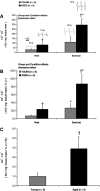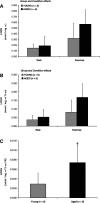Sedentary aging increases resting and exercise-induced intramuscular free radical formation
- PMID: 20507973
- PMCID: PMC2928589
- DOI: 10.1152/japplphysiol.00354.2010
Sedentary aging increases resting and exercise-induced intramuscular free radical formation
Abstract
Mitochondrial free radical formation has been implicated as a potential mechanism underlying degenerative senescence, although human data are lacking. Therefore, the present study was designed to examine if resting and exercise-induced intramuscular free radical-mediated lipid peroxidation is indeed increased across the spectrum of sedentary aging. Biopsies were obtained from the vastus lateralis in six young (26 + or - 6 yr) and six aged (71 + or - 6 yr) sedentary males at rest and after maximal knee extensor exercise. Aged tissue exhibited greater (P < 0.05 vs. the young group) electron paramagnetic resonance signal intensity of the mitochondrial ubisemiquinone radical both at rest (+138 + or - 62%) and during exercise (+143 + or - 40%), and this was further complemented by a greater increase in alpha-phenyl-tert-butylnitrone adducts identified as a combination of lipid-derived alkoxyl-alkyl radicals (+295 + or - 96% and +298 + or - 120%). Lipid hydroperoxides were also elevated at rest (0.190 + or - 0.169 vs. 0.148 + or - 0.071 nmol/mg total protein) and during exercise (0.567 + or - 0.259 vs. 0.320 + or - 0.263 nmol/mg total protein) despite a more marked depletion of ascorbate and uptake of alpha/beta-carotene, retinol, and lycopene (P < 0.05 vs. the young group). The impact of senescence was especially apparent when oxidative stress biomarkers were expressed relative to the age-related decline in mitochondrial volume density and absolute power output at maximal exercise. In conclusion, these findings confirm that intramuscular free radical-mediated lipid peroxidation is elevated at rest and during acute exercise in aged humans.
Figures




Similar articles
-
Electron paramagnetic spectroscopic evidence of exercise-induced free radical accumulation in human skeletal muscle.Free Radic Res. 2007 Feb;41(2):182-90. doi: 10.1080/10715760601028867. Free Radic Res. 2007. PMID: 17364944
-
Molecular detection of exercise-induced free radicals following ascorbate prophylaxis in type 1 diabetes mellitus: a randomised controlled trial.Diabetologia. 2008 Nov;51(11):2049-59. doi: 10.1007/s00125-008-1101-1. Epub 2008 Sep 4. Diabetologia. 2008. PMID: 18769906 Clinical Trial.
-
Regulation of free radical outflow from an isolated muscle bed in exercising humans.Am J Physiol Heart Circ Physiol. 2004 Oct;287(4):H1689-99. doi: 10.1152/ajpheart.00148.2004. Epub 2004 May 20. Am J Physiol Heart Circ Physiol. 2004. PMID: 15155256
-
Antioxidant functions of vitamins. Vitamins E and C, beta-carotene, and other carotenoids.Ann N Y Acad Sci. 1992 Sep 30;669:7-20. doi: 10.1111/j.1749-6632.1992.tb17085.x. Ann N Y Acad Sci. 1992. PMID: 1444060 Review.
-
The interaction of dietary carotenoids with radical species.Arch Biochem Biophys. 2001 Jan 1;385(1):13-9. doi: 10.1006/abbi.2000.2172. Arch Biochem Biophys. 2001. PMID: 11361009 Review.
Cited by
-
Relationship between sympathetic nerve activity and aortic wave reflection characteristics in postmenopausal women.Menopause. 2013 Sep;20(9):967-72. doi: 10.1097/GME.0b013e3182843b59. Menopause. 2013. PMID: 23531685 Free PMC article.
-
Oxidative stress and enhanced sympathetic vasoconstriction in contracting muscles of nitrate-tolerant rats and humans.J Physiol. 2012 Jan 15;590(2):395-407. doi: 10.1113/jphysiol.2011.218917. Epub 2011 Nov 21. J Physiol. 2012. PMID: 22106180 Free PMC article. Clinical Trial.
-
Vitamin E in sarcopenia: current evidences on its role in prevention and treatment.Oxid Med Cell Longev. 2014;2014:914853. doi: 10.1155/2014/914853. Epub 2014 Jul 6. Oxid Med Cell Longev. 2014. PMID: 25097722 Free PMC article. Review.
-
Oxidative Stress Risk Is Increased with a Sedentary Lifestyle during Aging in Mexican Women.Oxid Med Cell Longev. 2021 Oct 25;2021:9971765. doi: 10.1155/2021/9971765. eCollection 2021. Oxid Med Cell Longev. 2021. PMID: 34733404 Free PMC article.
-
Ascorbic acid improves brachial artery vasodilation during progressive handgrip exercise in the elderly through a nitric oxide-mediated mechanism.Am J Physiol Heart Circ Physiol. 2016 Mar 15;310(6):H765-74. doi: 10.1152/ajpheart.00817.2015. Epub 2016 Jan 22. Am J Physiol Heart Circ Physiol. 2016. PMID: 26801312 Free PMC article.
References
-
- Bailey DM, Davies B, Young IS. Intermittent hypoxic training: implications for lipid peroxidation induced by acute normoxic exercise in active men. Clin Sci (Lond) 101: 465–475, 2001 - PubMed
-
- Bailey DM, Lawrenson L, McEneny J, Young IS, James PE, Jackson SK, Henry R, Mathieu-Costello O, McCord JM, Richardson RS. Electron paramagnetic spectroscopic evidence of exercise-induced free radical accumulation in human skeletal muscle. Free Radic Res 41: 182–190, 2007 - PubMed
-
- Bailey DM, Young IS, McEneny J, Lawrenson L, Kim J, Barden J, Richardson RS. Regulation of free radical outflow from an isolated muscle bed in exercising humans. Am J Physiol Heart Circ Physiol 287: H1689–H1699, 2004 - PubMed
-
- Bassett DR, Jr, Howley ET. Limiting factors for maximum oxygen uptake and determinants of endurance performance. Med Sci Sports Exerc 32: 70–84, 2000 - PubMed
-
- Bejma J, Ji LL. Aging and acute exercise enhance free radical generation in rat skeletal muscle. J Appl Physiol 87: 465–470, 1999 - PubMed
Publication types
MeSH terms
Substances
Grants and funding
LinkOut - more resources
Full Text Sources
Medical

